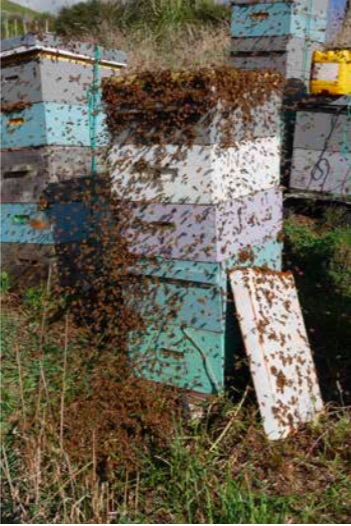Burning Questions
Frank Lindsay, NBA Life Member

ROBBING EXPLAINED
Published in the New Zealand Beekeeper, February 2016
A Wellington beekeeper asked me to explain some of my comments posted on the Wellington Beekeepers Association website. The beekeeper inquired,
“Your page on the Wellington beekeepers site makes a few references to robbing. I tend to think that means thieving—the bees want to steal the wax/honey mixture back. Thing is, your article speaks of it as spreading disease. If they weren’t sick in the first place, why would they be spreading disease?
And considering beeswax can be used in candles or furniture wax, why is it a concern about throwing this wax away and not using it?”
I replied,
Robbing is the term most beekeepers use universally but yes, it’s thieving.
In his book A dictionary of scientific and practical beekeeping, published in 2001, Robert B Gulliford defined ‘robbing’ as “the act of stealing honey and taking it back to their hive”.
At the end of the honey flow, as many as 20,000 workers have very little to do in each hive but they are out looking for nectar. They will also test any hive in the area to see if it’s defended. If not closed down to a small winter entrance, some will sneak in, just as wasps do. Once they obtain the hive’s scent, they can walk in unchallenged. They go back to their own hive, recruit more foragers and the battle starts.
We can unconsciously assist these robber bees by taking surplus honey off in the middle of the day after the honey flow has finished. We break down the hive’s defence by applying smoke to the entrance, preventing the alarm pheromone being detected by other bees in the hive. We split the hives to inspect the brood before removing any honey supers, as any broken cells put a plume of nectar in the air, attracting robber bees to the hive. Robbing bees can detect nectar two kilometres away.
Because the bees concentrate their defences at the entrance, any honey in the honey supers not defended or covered is fair game. Once robbers start, they usually strip a hive in a couple of days and you end up with a dead, empty hive, capped brood, and pollen, but no honey.
To stop robbing in a suburban setting, close the hives with grass and turn on the sprinkler to water everything down. This usually discourages the robbers but hives should be closed down to just one or two bee-widths, as the robbers will try getting in again for the next week before giving up.
I have had some very good production hives: those that outperform others in the same apiary, only to find they were ‘robbers’ that went into different hives in the apiary, robbing even when the honey flow is on.
You can identify robbing bees when they leave the hive. Their abdomens are full (translucent against the sun because they are full of nectar), and they have to climb up the front of the hive 50–100 mm before they take off because of the weight they are carrying. Normal foragers flop on to the landing board, go into the hive and disgorge their load to waiting bees, then are off again within five minutes, taking off immediately as they leave.
Robber bees only take liquid nectar or honey. It doesn’t necessarily mean that the hive being robbed was diseased, but it could be weakened with nosema, chalkbrood and if the beekeeper misses it, AFB.
Bees could have robbed a diseased hive but not show any clinical signs of AFB until they perhaps start using that honey. That’s is why you have to put an 18-month quarantine on an apiary if a diseased hive is found. Generally where there’s one diseased hive, there are more. However, the extent of disease may not show up until the following spring, when hives become stressed by shortages of pollen and nectar and bad weather.
Nosema ceranae is spreading amongst New Zealand hives just by bees sharing the same drinking water. Beekeepers spread most diseases when they exchange frames of brood and honey between a weak and a strong hive to boost the weak hive in the spring.

The bees I referred to in my apiary article in the June 2015 journal (Lindsay, 2015) started with a swarm in a roof cavity 100 metres away. The robbers overwhelmed the hive because varroa had weakened it. But then, just like wasps, robbers will move on to good hives, fighting with the defenders, killing most of them, then robbing out the reserves by uncapping the honey cells. They discard the wax cappings. Bees never take wax back to their hive, preferring to make their own or, when nectar is short, remoulding old comb. It’s probably a hygiene thing.
Beeswax is very attractive to bees that will investigate it looking for nectar. It’s not good practice to discard any brace comb on the ground when inspecting and cleaning hives. It’s a valuable resource that can be turned into candles or cash. Any nectar in this wax attracts bees.
I trust this answers your questions.
Source Lindsay, F. (2015, June). Preparing for winter. The New Zealand BeeKeeper, 23(5), 21–25.